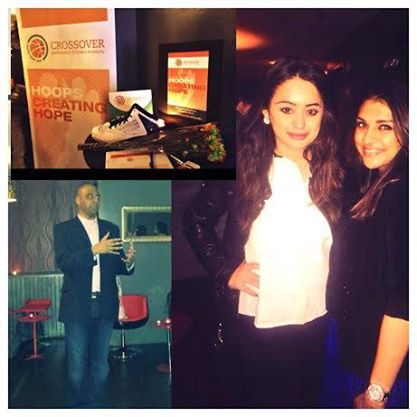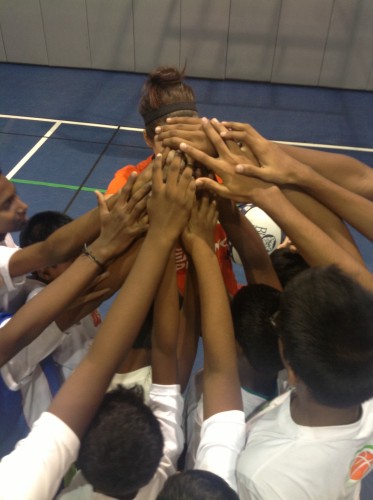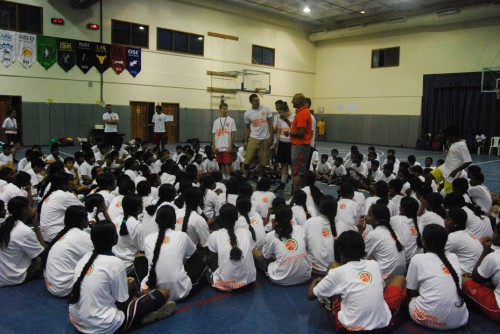
When I heard about the Crossover Basketball program, an international education program, the first non-profit [501(c)3] international education program in India to leverage athletic values and skill to develop academic opportunities for Indian students, I knew I wanted to learn more.
I reached out to the founder, Shaun Jayachandran, to learn more about the initiative and his journey thus far. I recently spent a few months in India trying to connect with my heritage through my own Indian experiences, so I can relate to Shaun’s desire to create such a program in the “motherland,” even though he spent his entire life in North America.

Tell us about yourself and about the Crossover program.
I am the son of Indian immigrants to Canada. Born and raised in Calgary, Alberta and moved to Northern Virginia (D.C. area) at 16, right before my junior year. My mom and dad are incredibly dedicated to their two sons and worked hard to make sure us the best opportunities possible. My dad also coached me in soccer for several years and was instrumental in my understanding of society through sports. Having taught science and worked on diversity initiatives in private schools for the last eleven years, and earned my Masters in Educational Leadership, I have been afforded the chance to think and create programs that go much beyond the classroom and how to impact character and development.
I began Crossover in 2010 after seeing the trend of growth of basketball in India, but also upon researching education statistics and seeing the huge gap between the haves-and-have-nots. Even now in India – more than 90 percent of children never complete high school with 58 percent of students leaving before the end of primary school. That is an astonishing number for a country associated so highly with education here in the U.S.
Crossover Basketball‘s mission is to use basketball as a vehicle of change in communities in India by combining the ideas of a sport and imparting the values of leadership, character, teamwork, and communication with the goal of inspiring and preparing those students to continue in their educational pursuits through the university level.
Why did you decide to create this program? Tell us about your journey.
I created this program as a way to connect pieces of my life and character that I feel passionately about. I love the openings of education, the lessons of basketball and sport, and my cultural heritage from India. When thinking about how to put these pieces together, basketball makes sense for a country as densely populated as India, since it does not require much space or equipment, whereas soccer and cricket need a lot of field space.
This experience and journey has also allowed me to connect back to a culture that often felt divided from me, one that I knew I was a part of and yet in trying to find myself, I had trouble with the Indian part of my hyphenated self, since so much of being a first generation person in the past was trying to not point out your differences. I know have my story of India – people whom I interact with, streets and restaurants that I know, places that I have journeyed, all without the protection or supervision of my parents.
Crossover 2014 from Crossover Basketball on Vimeo.
What were the major roadblocks working against you?
The major roadblock has always been creating sustainable funding both from people and corporations. It is hard for many people to imagine that Crossover runs purely on volunteer efforts and no one takes a salary. Connecting the Indian-American community with a new form of philanthropy that involves sport is not intuitive to most and therefore creates hesitation in belief that the program would even get off the ground and have impact. We are such a blessed community and yet the translation of this towards growing the bottom of the economic pyramid is a difficult concept.
It is easy to think of education as simply needing more hard work, more hours studying, and more textbooks, but the reality is, these are children and therefore they need to be connected with on an emotional and developmental level as well.
Since culturally, sports are not given much importance in a child’s development in India, how did people react when they first heard of your program?
People had a hard time grasping the concept. They either thought we were trying to build NBA players to make money from or that this was not an effective way to cut dropout rates and poverty. The development of leadership, character, teamwork and communication are not often skills thought of with academic success and yet these are the separating factors that generate wins for those in any field – that produces the CEO’s and Chiefs – and these are skills that can be learned and taught through sport and then translated into the classroom.
This year Crossover will impact 450 students – that’s 450 families who will have their futures changed simply because we are able to translate what matters most – that people care about the education of each child.
What advice do you have for someone trying to start a free educational program?
Do your research, engage with other NGO’s, attend as many conferences and lectures as possible. I developed an outlook for the program and extensively have used social media to create and grow Crossover. The amount of conversations you are able to generate over a resource such as Twitter is a game-changer in being able to make connections and engage potential volunteers. Develop a plan and when it seems like you’re just about ready to launch, that’s when you do it. Otherwise you will never be ready to change the world – there are always too many reasons to not try.
How can the Brown Girl community get involved in supporting Crossover?
They can get involved by becoming a volunteer, either domestically or applying to join the faculty in India next summer, as well as helping us raise money. We are very proud that the cost for ONE student to take part in our program for two weeks is only $100. Compare that to the cost of attending any summer camp in the U.S., without the educational component, and most are at least $300 per week.
This year, the Crossover program runs July 7 to July 18. There is also a Crossover Sport in Education Conference on July 12 – a one day FREE event for teachers, educators, ministers, and parents to come together, learn, and share ideas about how sports can enhance the educational experience and connection for students when applied and approached through the proper lens.
All images and video provided by Shaun Jayachandran.






